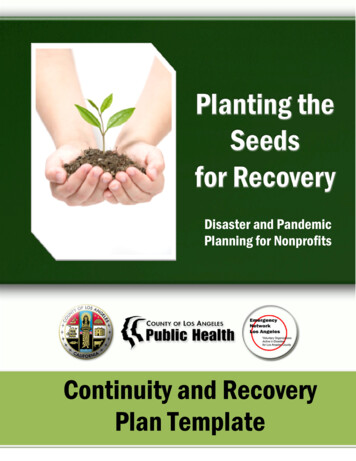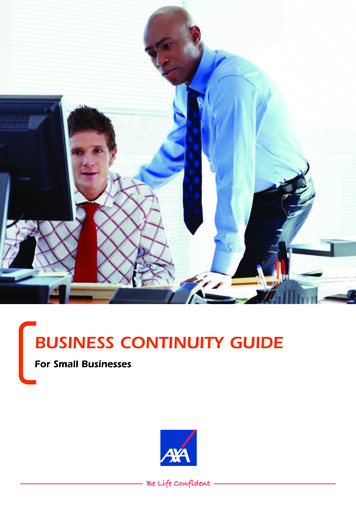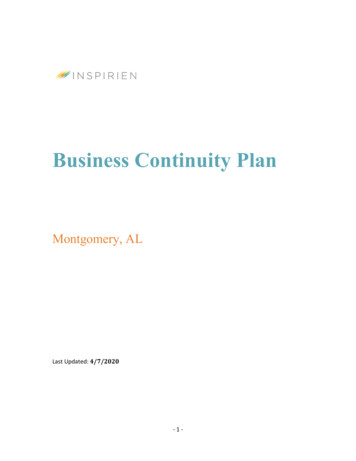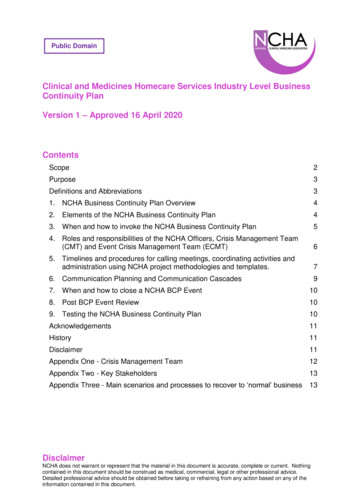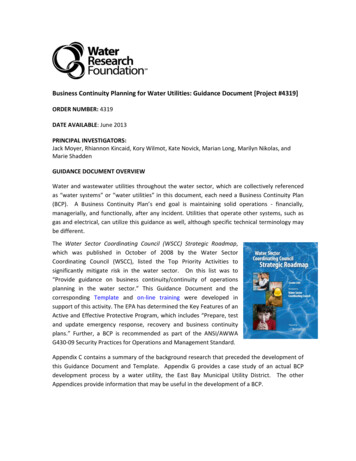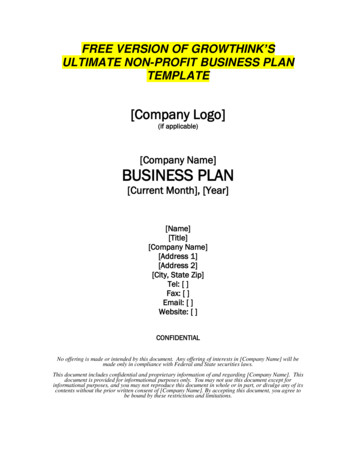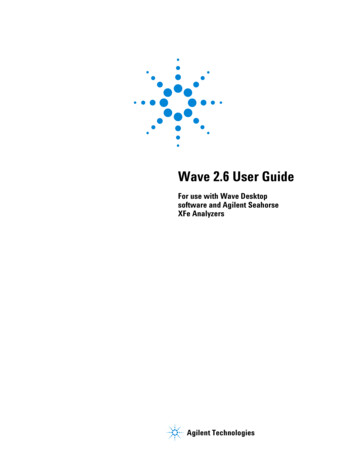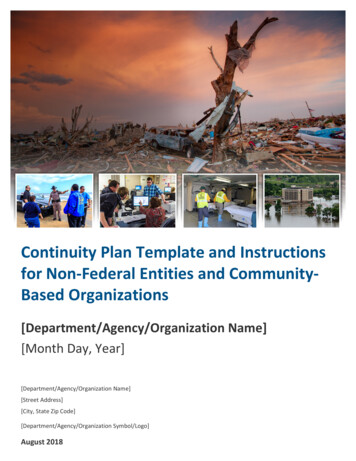
Transcription
Continuity Plan Template and Instructionsfor Non-Federal Entities and CommunityBased Organizations[Department/Agency/Organization Name][Month Day, Year][Department/Agency/Organization Name][Street Address][City, State Zip Code][Department/Agency/Organization Symbol/Logo]August 2018
CONTINUITY PLAN TEMPLATE FOR NON-FEDERAL ENTITIESAUGUST 2018CONTINUITY PLAN TEMPLATE AND INSTRUCTIONSThis template provides instructions, guidance, and sample text for the development ofContinuity Plans and programs in accordance with the Continuity Guidance Circular (CGC)dated February 2018. The guidance in this template is designed for non-federal entities, andmay be useful for all levels of state, local, territorial, and tribal governments, the privatesector, non-governmental organizations, and community-based organizations. The firstportion of this template is dedicated to organizational operations associated with thecontinuation of essential functions. The second portion of the template is reserved forcontinuity program management and appendices. Annex 3 at the end of the documentcontains a ready-to-use outline of this template.This document is organized in a flexible format so that organizations may select all, or onlycertain sections of the template to develop or improve their plan. While using this template toassist in developing continuity plans and programs, organizations are encouraged to tailor thetemplate to meet their specific continuity planning requirements. It should be noted, that in itscurrent format, the template is unclassified; however, organizations should be aware of theneed to protect specific continuity planning information and secure their individual continuityplans as appropriate. After using this template, jurisdictions and organizations may want to usethe Continuity Assessment Tool (CAT) to evaluate their continuity plan and program.Note: Once organization-specific information is entered into the body of the template, deletethe italicized, highlighted instructions.An electronic version of this document, in portable document format (PDF) and Microsoft Word is available on the FEMA National Continuity Programs, Continuity Resource Toolkitwebsite at https://www.fema.gov/continuity-resource-toolkit. Questions concerning thistemplate may be directed to fema-cgc@fema.dhs.gov.National Continuity ProgramsPolicy, Plans, and Evaluation DivisionFederal Emergency Management Agency500 C Street, SW, Suite 528Washington, DC 20472FEMA NATIONAL CONTINUITY PROGRAMSii
CONTINUITY PLAN TEMPLATE FOR NON-FEDERAL ENTITIESAUGUST 2018PROMULGATION STATEMENTThis letter, when signed by the head of the organization, serves as a formal authorization of, andintroduction to, the plan and its purpose. It gives the plan official status, and the organization authorityand responsibility to perform their tasks.Include the mission statement of the organization and summarize the scope and purpose of developing acontinuity plan (what the plan is, who it affects and the circumstances under which it should be executed).The [Organization Name]’s mission is to [enter mission statement].To accomplish this mission, the organization must ensure its most important and time critical operationsare performed efficiently and with minimal disruption, especially during an emergency. This documentprovides guidance for implementing the Continuity Plan and programs to ensure the organization iscapable of conducting its essential missions and functions under all threats and conditions.Key personnel who may be activated under this plan are collectively known as the [insert name ofgroup, such as Continuity Team]. Upon plan activation, these members [will/may] deploy to [insertalternate location name or placed on telework status] where they will establish an operationalcapability and perform essential functions within the designated recovery time objective (RTO) andcontinue until normal operations can be resumed.This plan is developed in accordance with guidance in the Continuity Guidance Circular, dated February 2018; Management Directive [enter Directive number and title]; and Other related directives and guidance [list].[Organization Head signs here][Enter Organization Head’s name here][Enter Organization Head’s title here][Enter Organization Name here]FEMA NATIONAL CONTINUITY PROGRAMSiii
CONTINUITY PLAN TEMPLATE FOR NON-FEDERAL ENTITIESAUGUST 2018CONFIDENTIALITY STATEMENTShould include a description of any protections provided to the continuity plan to prevent disclosure of plantactics and personal information to those who may intend harm to the organization or its personnel.Depending on the sector, this may include: Legislative exemption of continuity plans from public disclosure laws Designation of plan ‘For Official Use Only’This document along with subsidiary plans and supporting documents, contains confidential informationand are for official use only as provided in [enter applicable regulation]. These documents are to becontrolled, stored, handled, transmitted, distributed, and disposed of in accordance with the standardprocedures followed for confidential information at [organization name] and are not to be releasedwithout prior approval of the [organization head title] to the public or other employees who do nothave a valid “need to know.”FEMA NATIONAL CONTINUITY PROGRAMSiv
CONTINUITY PLAN TEMPLATE FOR NON-FEDERAL ENTITIESAUGUST 2018Table of ContentsPROMULGATION STATEMENT . iiiCONFIDENTIALITY STATEMENT . ivESSENTIAL FUNCTIONS . 1Business Impact Analysis Summary . 1Essential Functions and Resource Summary. 1Support Functions . 1Interdependencies . 1Mutual Aid . 2Expected Costs . 2ESSENTIAL RECORDS AND IT FUNCTIONS . 4Identification and Storage. 4Backup and Protection . 4Recovery. 5HUMAN RESOURCES . 6Roles and responsibilities. 6Senior Leadership . 6All Personnel . 7Continuity Personnel . 7Succession and Delegations of Authority. 10Additional Human Resources Considerations . 12Personal Recovery Assistance . 12Replacing Staff . 13COMMUNICATIONS . 14Resilient Systems. 14Senior Leadership Communications . 14Alert and Notification. 15Continuity Event Communications . 15Contact Rosters . 16Tracking the Threat . 16ALTERNATE LOCATIONS AND TELEWORK . 17Space and Infrastructure Summary . 17Access to Communications, Internet, and Remote Servers. 17Contracts . 18Maps, Directions, Security, and Access. 18Telework. 18Activation/Relocation . 19RECONSTITUTION. 21Procedures . 21FEMA NATIONAL CONTINUITY PROGRAMSv
CONTINUITY PLAN TEMPLATE FOR NON-FEDERAL ENTITIESAUGUST 2018Reconstitution Team . 22DEVOLUTION . 23Contract. 23Transfer of Essential Functions . 24BUDGETING AND ACQUISITION . 26Cost Prevention, Mitigation, and Reallocation . 26Emergency Procurement . 26MULTI-YEAR STRATEGIC PLANNING . 27TRAINING, TESTING, AND EXERCISING (TT&E). 28Training . 29Testing and Exercises . 29After-Action Evaluation and Improvement Planning . 32APPENDIX A: LIST OF SUPPORT APPENDICES. 33APPENDIX B: AUTHORITIES AND REFERENCES. 34APPENDIX C: ACRONYMS . 35APPENDIX D: PLAN MAINTENANCE . 36Annual Review. 36Record of Distribution . 36ANNEX 1: JOB AID – Synchronization Matrix . 37ANNEX 2: JOB AID – Alternate Location MOU Template . 41ANNEX 3: Continuity Plan Outline. 52Table 1: SAMPLE Essential Function Table. 2Table 2: SAMPLE Essential Records Database . 4Table 3: SAMPLE Continuity Personnel Roster . 8Table 4: SAMPLE Assignment of Responsibilities . 9Table 5: SAMPLE Go Kit Contents . 10Table 6: SAMPLE Order of Succession List . 11Table 7: SAMPLE Communications Systems Tracking Table . 14Table 8: SAMPLE Continuity Event Communications Tracking Table . 16Table 9: SAMPLE Alternate Location Checklist . 20Table 10: SAMPLE Reconstitution Checklist . 21Table 11: SAMPLE Reconstitution Team Responsibility Chart . 22Table 12: SAMPLE TT&E Documentation . 28Table 13: SAMPLE Corrective Action Program Documentation . 32Table 14: SAMPLE Continuity Program Review Table. 36Table 15: SAMPLE Continuity Plan Distribution Record . 36FEMA NATIONAL CONTINUITY PROGRAMSvi
CONTINUITY PLAN TEMPLATE FOR NON-FEDERAL ENTITIESAUGUST 2018ESSENTIAL FUNCTIONSThis section should include a list of the organization’s most time critical and essential functions (EFs) thatcannot be left undone for 30 days without risking failure of mission or loss of trust, respect, and funding.The Continuity Plan should identify the resources, space requirements, costs, interdependencies, work flowprocesses, and support functions that ensure the continued performance of the organization’s EFs.The CGC describes the process of identifying and prioritizing EFs, conducting a business process analysis(BPA), conducting a business impact analysis (BIA), and developing risk mitigation strategies. (ReferenceCGC pg. 14-16, 18.) Jurisdictions and organizations may choose to complete this section in narrativeformat, use the table on the following page, or both, to outline their EFs.Business Impact Analysis SummaryThe BIA may be an important reference for all the organization’s disaster management plans. A singleanalysis should be shared and referenced in each plan to ensure consistent strategies. (Reference CGC pg.17-18.)Summarize the results of the BIA, noting how threats affect: Requirements for a continuity facility and infrastructureRisks to essential records, servers, data lines, and IT equipmentRisk prevention and mitigation tacticsEssential Functions and Resource SummarySummarize the results of the BPA for each EF, including: Recovery time objectives (RTO)Staffing (workers and managers) required to complete the functionEquipment, supplies, records, IT access, and communications necessary to conduct workFacility space and infrastructure requirementsSupporting activitiesDependenciesExpected costs for continuityInclude a work flow process description and/or diagram or reference the appropriate standard operatingprocedure (SOP) that details every step to complete each EF. (Imagine that a temporary employee withthe required credentials, but without knowledge of organization-specific procedures comes in to assist;outline the steps so they complete the work as intended.) (Reference CGC pg. 16.)Support FunctionsDescribe internal support activities that will help ensure the ability to support EFs, including issues likeplans for pay and benefits, administrative support, and establishing a break schedule for Continuity Teammembers. (Reference CGC pg. 21)InterdependenciesExplain how interdependencies will be managed. Who does the organization count on to complete your EFs?o Discuss what is needed.FEMA NATIONAL CONTINUITY PROGRAMS1
CONTINUITY PLAN TEMPLATE FOR NON-FEDERAL ENTITIESAUGUST 2018How would these needs be accessed or accomplished if either or both organizations are incontinuity operations?o What are the RTOs?What other entities depend on you to complete their EFs? Does this create additional EFs for you?o Mutual AidWhere applicable include memoranda of understanding (MOU), memoranda of agreement (MOA),emergency contracts, or service level agreements (SLAs) that have been put in place to augment resourcesto support the continuation of essential functions. (Reference CGC pg. 21.)Expected CostsOutline or summarize the costs associated with the continuation of essential functions. This is differentfrom the continuity program budget. These costs are directly related to the implementation of thesupporting activities associated with the essential functions. (Reference CGC pg. 18.)Using CGC guidance, the organization has identified its EFs, a limited set of its overall functions thatmust be continued throughout, or resumed rapidly after, a disruption of normal activities. These EFshave been approved by [official title], are listed in [Table 1] below in priority order.Table 1: SAMPLE Essential Function TableEssential FunctionRecoveryTimeObjective[List max timeto resumefunction.]Responsible Personnel[List staff and managers responsible for essential function.]Resources[Insert required equipment, supplies, records, etc.]Work Location & Space Requirements[Insert organizationalessential functionhere][Insert continuity facility or telework location, IT, and communications accessneeds.]Supporting Activities[Insert essential supporting activities.]Interdependencies[Insert other entities who provide required work or resources. Include mutual aidagreements where applicable.]Expected Costs[Insert the costs associated with the implementation of the essential function.]Note: Repeat this table for each EF.FEMA NATIONAL CONTINUITY PROGRAMS2
CONTINUITY PLAN TEMPLATE FOR NON-FEDERAL ENTITIESAUGUST 2018Note: Repeat this work flow process for each EF.FEMA NATIONAL CONTINUITY PROGRAMS3
CONTINUITY PLAN TEMPLATE FOR NON-FEDERAL ENTITIESAUGUST 2018ESSENTIAL RECORDS AND IT FUNCTIONSThis section addresses essential records management requirements needed to support EFs and sustainlegal and financial responsibilities during a continuity event. Identification, protection, and readyavailability of databases, software, and electronic and hard copy documents are critical elements of asuccessful Continuity Plan and program. (Reference CGC pg. 24.)Identification and StorageIt is critical to thoroughly and accurately identify every document, record, microfilm/fiche, photo, piece ofdata, software program, or other hard copy or electronic information required to conduct each EF orreconstitute full operations. Identify who is responsible for maintaining this list, and where it is stored.The organization should establish a system for naming and storing documents that makes them easy tolocate on primary or backup storage devices if desktop maps are lost. Consult with the IT division for bestpractices for naming and storing files, and train staff on these systems.[Insert office/title] maintains a complete inventory of essential records, along with their locations andinstructions for access at [insert location/office].Table 2: SAMPLE Essential Records DatabaseEssential Record,File, or DatabaseMapping DatabaseLicensed SpillCleanupContractors ListRegional Dams ListPollution/ChemicalIncident DatabasePublic and PrivateSewage unction#1 & 3Form itionedatAlternateLocationHandCarried HardcopyFunction#2Function#3 & 4HardcopyFunction#3, 4, & arterlyXXNXNNAnnuallyMonthlyQuarterlyXYTo ensure rapid identification and recovery, essential records will be named and stored according topolicies developed by IT. This policy is included in the Essential Records Annex and [other location(s)].Backup and ProtectionOnce this has been done, these documents should be formally designated as essential records. As such,they should be stored, backed up, and a Recovery Plan should be identified.FEMA NATIONAL CONTINUITY PROGRAMS4
CONTINUITY PLAN TEMPLATE FOR NON-FEDERAL ENTITIESAUGUST 2018Every essential record should be backed up outside of the organization’s servers to ensure they can beaccessed if the server room is damaged by the incident. Solutions range in security and cost, so increasedprotection may need to be included in the multi-year strategic plan (see Budgeting and Acquisition section).Electronic backup storage options include, but are not limited to contracts with a data storage andrecovery facilities, maintaining offsite servers at other locations, cloud storage, portable media such asexternal hard drives or thumb drives, tape backups, etc.Hard copy backup storage options include, but are not limited to, maintaining blank copies of documentsor forms offsite, utilizing a government or private sector documents storage or library facility, ormaintaining secure duplicate files at the alternate location(s).Electronic records, and the records inventory, are backed-up using [describe system and/or process].Additional protection is provided using [describe system and/or process(es)]. If they are lost, recoverywill be conducted by [describe responsible party and/or process].Hard copy records are backed-up using [describe system and/or process]. Additional protection isprovided using [describe system and/or process(es)]. If they are lost, recovery will be conducted by[describe responsible party and/or process].RecoveryRecovery experts should be identified to salvage damaged records. It may be necessary to obtain contractsprior to an event to assure service within an established timeframe. Copies of the contract should be placedin the Essential Records Database (Table 2).Document and photo recovery is a very expensive process, so storage and backup protections should be ascareful and thorough as possible.Recovery is expensive, time consuming, and may not be completely effective, so every effort should bemade to prevent damage to essential records. If essential records are damaged, recovery will beconducted by [insert organization]. Plans to cover the costs of recovery are included in the Budgetingand Acquisition section.FEMA NATIONAL CONTINUITY PROGRAMS5
CONTINUITY PLAN TEMPLATE FOR NON-FEDERAL ENTITIESAUGUST 2018HUMAN RESOURCESRoles and responsibilitiesInclude a description of roles and responsibilities for: Senior leadershipo Procedures and authorities for activation of a continuity evento Adjusted responsibilities to manage the limited EFsNon-continuity personnelContinuity Team personnel[Other personnel as necessary]Senior LeadershipContinuity Plan activation is a scenario-driven process that allows flexible, scalable response to allhazards/threats that might disrupt operations. Continuity Plan activation will not be required for allemergencies or disruptions.The process for activating the continuity plan has three basic steps:(1) The [organization head] is aware of, or is notified, that a disruption to normal operations isplanned, is anticipated, or has occurred.(2) The [organization head] evaluates the situation along with its potential, anticipated, or knowneffects on agency operations and decides whether to activate the Continuity Plan.(3) The [organization head] initiates the process to inform all employees of the situation and theactions they should take.This process may be repeated several times in relation to a single event. For example, a hurricane isforecast to hit the state. After becoming aware of the initial forecast, leadership may decide only to informemployees that the agency management is aware of the forecast and will be monitoring the situation. Asthe hurricane comes closer to the state, leadership might decide to close the agency so that employeescan take shelter at home. After the hurricane hits, leadership may decide to activate the Continuity Plan.Based on the type and severity of the emergency, the Continuity Plan may be activated by one of thefollowing methods:(1) The state governor, county executive or county commissioner, local mayor, city mayor, or cityadministrator may initiate continuity activation.(2) The [Organization Head], or a designated successor, may initiate the Continuity Plan activationfor the entire organization, based on an emergency or threat directed at the organization.(3) [Insert additional activation measures here].The decision to activate the Continuity Plan and related actions will be tailored for the situation basedon projected or actual impact.FEMA NATIONAL CONTINUITY PROGRAMS6
CONTINUITY PLAN TEMPLATE FOR NON-FEDERAL ENTITIESAUGUST 2018SAMPLE: Decision ProcessAll PersonnelEvery member of the organization will train and prepare in advance for a continuity event so they areprepared to act quickly in an emergency. Each individual will also develop a Family Support Plan toincrease personal and family preparedness. The www.ready.gov website provides guidance fordeveloping a Family Support Plan and includes a “Get Ready Now” pamphlet that explains theimportance of planning, and a template that can be tailored to meet family-specific planningrequirements.Personnel AccountabilityIt is important to account for all personnel during a continuity event. The [insert office/title] willaccount for personnel using [insert accountability process here, such as call trees, an automatedsystem, a 1-800 number, etc.]. Accountability information is reported to the [insert office/title] at[insert number] hour intervals. The process will continue until all personnel have been accounted for.Continuity PersonnelThe organization has determined the positions necessary to conduct essential functions, and toauthorize and approve the work. Key positions include the Continuity Coordinator, Continuity Teammembers, senior leadership and their successors, and others who are assigned continuityresponsibilities. These individuals will report to the alternate location or other assigned location. A copyof the current roster is found at [insert location]. The [Insert office/title] is responsible for maintainingthe roster and ensuring personnel are correctly matched to required positions.FEMA NATIONAL CONTINUITY PROGRAMS7
CONTINUITY PLAN TEMPLATE FOR NON-FEDERAL ENTITIESAUGUST 2018Table 3: SAMPLE Continuity Personnel RosterFunctionEF #1: Approveand overseecleanup ofcontaminatedsites.Title/ PositionNameDivision Head,John SmithEnforcementand RemediationDivisionAlternate:Jane DoeDeputy DivisionHead,Enforcement andRemediationDivisionChief,Sally DuneEnforcementBranchTelephone NumbersH: (###) ###-####W: (###) ###-####C: (###) ###-####Alternate:Deputy Chief,EnforcementBranchH: (###) ###-####W: (###) ###-####C: (###) ###-####Jim RichH: (###) ###-####W: (###) ###-####C: (###) ###-####H: (###) ###-####W: (###) ###-####C: (###) ###-####Additional InformationInsert other organizationrequired information, i.e.duty station andaddressesInsert other organiza
CONTINUITY PLAN TEMPLATE FOR NON-FEDERAL ENTITIES AUGUST 2018 FEMA NATIONAL CONTINUITY PROGRAMS ii CONTINUITY PLAN TEMPLATE AND INSTRUCTIONS This template provides instructions, guidance, and sample text for the development of Continuity Plans and programs in accordance with the Continuity Guidance Circular (CGC) dated February 2018.
